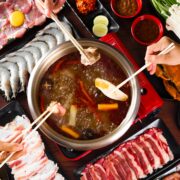Web content writer. Mother to a cat named Fatty and…

One evening, my girlfriend and I were eating our favorite pizza: a thin-crust pepperoni crunch.
Each slice was covered with spicy pepperonis and crunchy potato strings. Covered liberally in hot sauce, every bite was hot, rich, and crispy.
A few minutes after finishing our meal, my girlfriend felt woozy and her heart started beating fast.
She has hypertension, so she checked her blood pressure. It was really high so she had to take clonidine – a pharmaceutical drug used to relax blood vessels to lower blood pressure.
We waited for a few minutes for the drug to work but it wouldn’t. She decided that we had to go to the ER.
Since I couldn’t drive she had to drive herself. On our way to the hospital, we were hoping that she wouldn’t get too woozy or get a stroke and crash the car.
Things got less scary when we arrived at the ER. The nurses and doctors did their thing and a few hours after that, we were allowed to go home.
We survived despite making a series of bad decisions that night but things could’ve been fatal – all because we wanted to eat greasy pizza despite knowing that one of us shouldn’t be eating fast food.
We do well avoiding sodium-rich food like patis, junk food, and canned goods, but like many people, we had a “minsan lang naman” mentality and gave in to our urges.
We’re now better at controlling ourselves. But my search for healthier food and low-sodium recipes has opened my eyes to the fact that there are a lot of seemingly healthy food that are actually rich in sodium.
Here’s a list of dishes that are surprisingly high in sodium:
Kimchi
670mg of sodium per 100 servings
South Korea’s national dish offers nutritional benefits both from the vitamin and fiber-rich cabbage as well as the good bacteria that have multiplied during the fermentation process. Unfortunately, kimchi is also rich in sodium. Since it uses a lot of salt to ferment the cabbage, a 100g serving of kimchi can have 670 milligrams of sodium. It can meet 29 to 45 percent of a person’s recommended daily limit.
If you want the goodness of kimchi without the high sodium, you can make your own. Not only will you be able to control how much salt goes in it, you can also save a lot of money.

Some Japanese Noodles
shoyu ramen, 1,490mg of sodium; miso ramen, 1,120mg of sodium

We look at ramen and udon and think, “What can possible be wrong with food that has a light, delicious broth, delicious noodles, some veggies and a few slices of glorious melts-in-your-mouth pork or beef?”
Well, they can both have lots of salt.
Depending on who prepared it, shoyu ramen can have 1,490mg of sodium while miso ramen can have 1,120mg of sodium.
Likewise, udon has a high sodium broth and the noodles are made with refined flour.
Like with kimchi, if you really want to eat ramen or udon, you can find low-sodium recipes to cook your own. When eating out, there are restaurants that are willing to adjust the amount of salt in their broth, but these are usually the more expensive Japanese restaurants.
Instant oatmeal
over 200mg of sodium

This one really surprised me, but the moral of the story here is: if its name has “instant” attached to it, it probably has a high amount of sodium to keep it fresh.
Instant oatmeal can have more than 200mg of salt per serving. Combined with other additives like sugar and flavoring, instant oatmeal may not really help you with your fitness goals. For the full benefits of oats, go for plain oats, steel-cut oats, or whole grain oats, and customize it. You can add raisins, berries, nuts, and cinnamon to give it flavor. If you eat oatmeal for breakfast, you can precook oatmeal the night before and heat it the next day.
Veggie burgers and other meat substitutes
400mg of sodium per patty

Despite being made of veggies, veggie burger patties, and other meat substitutes have lots of sodium to lengthen their shelf life and to make their texture and flavor resemble real meat. Some brands have 400mg of sodium per patty.
Instead of processed meat substitutes, try making your own fake meat with tofu, different types of mushroom, or banana blossoms. For burgers, my personal favorites are banana blossom patties and kamote burger.
Commercial salad dressing
200mg to 400mg of sodium in a couple spoons

Some people know that commercial salad dressings can be full of sugar and fat, but few know that they are also high in sodium. Just two spoons of commercial salad dressing can have 200 to 400mg of sodium. So for those of us who really love our veggies swimming in rich creamy dressings, we could already be consuming half of our daily limit.
For a low-sodium salad dressing, the easiest solution is to go for vinaigrette. If you’re not in the mood for a tangy salad, you can make your own dressing with buttermilk and yogurt and make it delicious with herbs and spices.
How much salt should we be eating, anyway?
A healthy female adult can consume up to 2,300mg of sodium per day. But when we reach 50 years old, our limit decreases to 1,500 mg. The same goes for women who are pregnant, breastfeeding, and hypertensive. If you are not yet diagnosed but have a family history of heart disease, it would help to consult your doctor and keep your sodium intake low as well.
We may look at the figure above and think, “I’m gonna have this and just reduce my sodium intake for the rest of the day.” But considering that sodium can be very sneaky, it’s best to play it safe and cut back on these food items.
What happens if we consume too much salt?

Consuming too much salt can lead to hypertension. This is a condition where your blood pressure is so high that it causes stress to your heart and blood vessels; it increases your risk to more serious health problems, such as heart disease.
The more dangerous aspect about hypertension is that it is hard to detect so you may live for years with it and not know that you have it. Symptoms like headaches, dizziness, and nape pain can be attributed to other conditions so people don’t automatically think what they are experiencing is hypertension.
In an interview with the Manila Times, Doctor Rafael Castillo of the International Society of Hypertension (ISH) stated that the best way to find out if you have hypertension is to have your BP taken.
If it turns out that you do have high blood pressure, you’ll have to make changes in your lifestyle, such as switching to a low sodium diet, take maintenance medication, be more active, and limit alcohol.
If you don’t have hypertension, it’s never too early to manage your sodium intake and live a healthier lifestyle. Knowing what to avoid and eating in moderation are small things compared to living with the risks, expenditures and worries that come with high blood pressure.
What's Your Reaction?
Web content writer. Mother to a cat named Fatty and a basil named Herby. Dreams of going off the grid and running an animal shelter with her wife.


